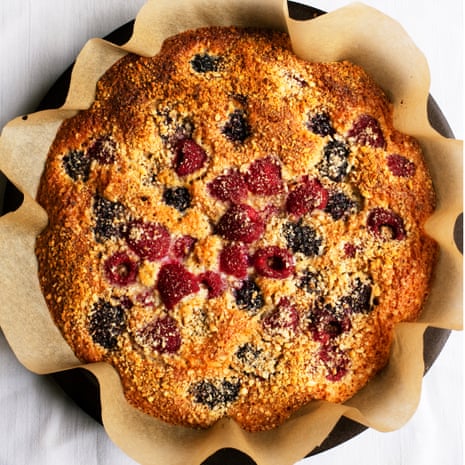There are punnets of blackberries and trays of green and purple figs. Late varieties of raspberries and the odd box of damsons. Even now, in the depths of autumn there are still a few plums and some fine, diminutive apricots from Turkey, more sweet and honeyed than the large French fruits we had in the summer. The market tables are groaning under the weight of pears and apples, and I have been coming home with bags of howgate wonders for baking, russets for eating with cheese and some maroon and green worcesters for crunching as I work.
The bounty of autumn fruit coincides neatly with the need for hot puddings, from a humble baked apple to crumbles and fruit crisps. I bake both apples and pears, the first for their sharp froth of snowy flesh, the latter for their fudgy, grainy quality. Pears need to be baked ripe; crisp examples will often disappoint, no matter how long you cook them for.
Almost all autumn fruits have an affinity with one another. Apples are happy in the company of berries or figs; stone fruits such as plums and apricots marry well to berries of all sorts, and pears and figs make a quietly pleasing pairing. Most of our home-grown fruits are sweet enough to require little extra sugar but equally will take on a mellow note when sweetened with maple or golden syrup or honey. However, I do suggest that the flavour of any berry or stone fruit can be illuminated by letting them rest a while with a light sprinkling of sugar. Do this to apples and blackberries and the filling for your crumble will be even more juicy.
This is also the time of year for a few of my favourite pork and fruit dishes. Chops with figs, roast loin with a rough textured sauce of apples and blueberries, and sausages stewed with onions, five spice and plums. This time, I have added slices of sweet apple and halved purple figs to sautéed pork chops with juniper. It made a pleasing change from apple sauce.
Browned butter, blackberry and hazelnut friand
My blackberry friand recipe is baked in one large dish rather than as individual cakes. I like it this way, poised somewhere between pudding and cake, served warm from the oven, in generous, fruit-studded spoonfuls. Keep a careful eye on the browning butter. It should be a rich hazelnut brown, but no darker. If there are any brown speckles, pour the butter through a fine sieve before using it.
Serves 4
butter 180g
hazelnuts 100g, skinned
plain flour 50g
icing sugar 180g
lemon zest 1 tsp
egg whites 5
blackberries and raspberries 250g
Set the oven at 160C fan/gas mark 4. Line a 24cm baking dish with baking parchment. Melt the butter in a small pan over a moderate heat. Watch carefully as the butter first froths and then calms down and starts to turn deep gold. Once it is walnut coloured and smells nutty and toasted, remove immediately from the heat and set aside.
Toast the hazelnuts in a shallow pan until they are golden. Move them around regularly to brown evenly. Tip into a food processor and reduce to fine crumbs.
Sift the flour and icing sugar into a large mixing bowl, then stir in all but 1 tablespoon of the ground hazelnuts. Stir in the lemon zest. In a separate bowl, beat the egg whites until they reach a soft, sloppy foam.
Make a deep well in the flour and sugar, then add the beaten egg whites and the melted butter. Combine everything lightly but thoroughly, then pour into the prepared dish. Scatter the blackberries and raspberries over the surface, then the reserved ground hazelnuts.
Bake in the hot oven for 35 minutes until risen and golden brown. The surface should be lightly crunchy; the inside soft and spongy. Remove from the oven and leave to settle for 10 minutes before serving.
Pork chop, apples, figs
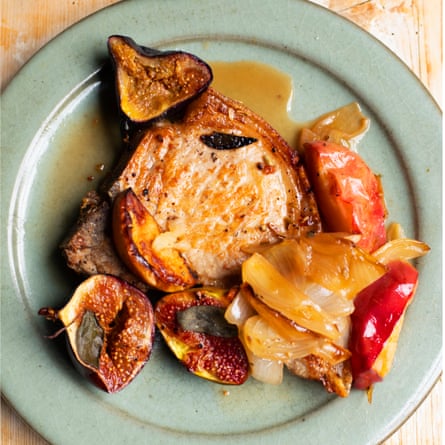
Pork and figs has long been a culinary marriage made in heaven for me. I have stirred the fruit into coarse pork terrines, eaten sausages with fig chutney, and dipped golden curls of crackling into fig jam. When you add the fruit to a pan of fried chops, they soften and almost collapse in the heat, sending their seeds out into the pork gravy. This is a dish for mashed potato, to which I would add some of the juices and fat from the roast.
Serves 4
olive oil 4 tbsp
pork chops 4
red onions 3, medium to large
juniper berries 6
rosemary 6 sprigs
apples 3, medium, any variety
figs 4
dry to medium sweet cider 500ml
chicken stock 1 litre
sage 4 leaves
Warm the olive oil in a wide, deep casserole over a moderate to high heat. Season the pork chops, then place them in the hot oil and leave them to brown lightly, turning them to cook on the other side once the fat is golden. I like to hold each chop on its side with kitchen tongs, pressing the rim of fat down into the pan so the fat becomes crisp and burnished. Lift the chops from the pan and put them in a single layer in a large roasting tin.
Peel the onions, slice them in half and then cut each half into 4. Fry the onions in the same pan in which you browned the pork, letting them cook for 15-20 minutes to a pale softness over a moderate heat, then, as they start to soften, add the juniper berries, lightly squashed with a pestle or the back of a spoon, and the rosemary sprigs.
Core and slice the apples. I get about eight slices from each apple depending on their size. Cut the figs in half.
Add the apples and figs to the onions and pour in the cider. Return the chops and their juices to the casserole, pour in the stock and bring to the boil. Lower the heat immediately so the liquid simmers, then cover with a lid and cook for 40 minutes or until the chops are tender.
Warm a little oil in a shallow pan, add the sage leaves and let them crisp, their colour darkening but not browning. Scatter the leaves over the chops and serve with knife, fork and spoon.
Baked autumn fruits
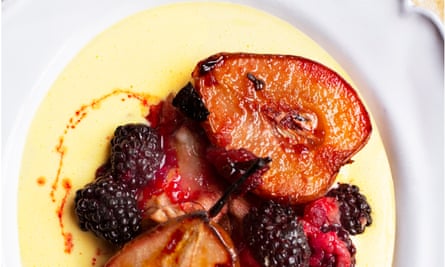
A dish of baked autumn fruits that we ate at Sunday lunch, finishing the leftovers for breakfast the next morning, with thick, chilled yogurt.
The fruit is roasted, pears first, then joined by apples and berries, and leaves the oven glistening with maple syrup and sherry. It is served with a proper vanilla custard. Even when ripe, which they should be for this, pears take longer than apples to cook, so they go in the oven first, and should be turned once or twice with the syrup and spices. You can peel the fruit if you wish, but I like the way the skin bakes in the heat. I suppose it depends whether you are the sort of person who eats the skin of a baked apple or not.
Serves 4
pears 500g, ripe
maple syrup 125ml
sherry 75ml
lemon 1
cinnamon 1 stick
cloves 6
apples 600g
blackberries 200g
For the custard
egg yolks 3
sugar 2 tbsp
cream 300ml
vanilla extract a few drops
Set the oven at 180C fan/gas mark 6. Slice the pears in half from stalk to base, scooping out the core with a teaspoon of you wish. (I generally find this unnecessary.) Place the pears in a baking dish. Mix together the maple syrup and sherry. Squeeze the juice of half the lemon into the syrup. Tuck the cinnamon stick and the cloves among the pears, then spoon the syrup over them and bake for 20 minutes in the preheated oven.
Cut the apples into quarters and cut out their cores. Remove the baking dish from the oven and tuck the apples among the pears. Spoon the syrup over them and the pears, scatter the blackberries over them, then return to the oven for a further 30 minutes or until all the fruits are soft.
To make the custard, beat together the egg yolks and sugar till thick and creamy. Warm the cream in a non-stick pan and add a few drops of vanilla extract. As it comes to the boil, pour it onto the eggs and sugar, stirring thoroughly. Rinse and dry the pan, pour the custard into it and place over a moderate heat. Stirring constantly, let the custard thicken a little, then remove from the heat and serve with the baked fruits. Cool the sauce as quickly as you can, stirring to let the steam out. (I transfer it to a cold dish or jug and plunge it into a bowl of ice.)
Autumn fruit pickle for cheese
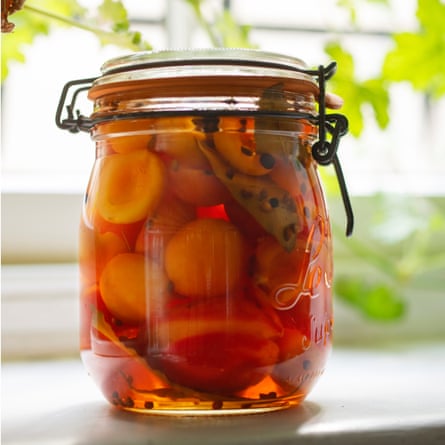
Leave the fruit in the boiling water until it is quite soft and tender enough to eat. No amount of time spent in the vinegar is going to soften hard fruit. You could use peaches instead of apricots, but I would skin them. Sterilising your preserving jars is essential. Wash them with hot soapy water and turn upside down to drain. Place them, correct way up on an oven tray then leave in preheated oven (160C fan/gas mark 4) for 10 minutes. The lids may distort in the oven, so let them sit in a pan of boiling water for 10 minutes, then drain on a clean tea towel before filling the jars with the hot preserve and sealing them.
Makes 1 x 900ml jar
cider vinegar 750ml
lemon juice of ½
granulated sugar 450g
juniper berries 10
black peppercorns 12
coriander seeds 2 tsp
bay leaves 6
apricots 500g, small, ripe
Put the cider vinegar in a non-reactive saucepan over a moderate heat, add the lemon juice, sugar, juniper berries, lightly crushed, the peppercorns, coriander seeds and bay leaves. Bring to the boil, then remove from the heat.
Cut the apricots in half and remove their stones, then pack all the fruit into the sterilised jars. Pour the pickling syrup and aromatics over, seal and leave to cool. The pickled fruits can be stored for several weeks in the fridge and are ready to eat within three days.
Apricot and raspberry crumble
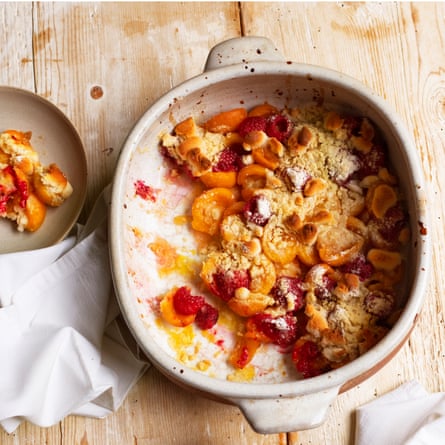
’Tis crumble season. I usually start with plum and greengage, then damson and then apple, before trying other less obvious fruits. Apricots work well because of their acidity, a contrast to the sugary rubble on top. Sweetness is introduced to the crumble in this recipe not with sugar but with nuggets of marzipan, lending a pleasing almond note to the fruit beneath. The recipe is something of a marriage between my blackberry and apple marzipan crumble (from 2018) and classic baked apricots, and is best with cream I think, rather than custard.
Serves 4-6
apricots 450g
raspberries 150g
orange juice of 1 medium
plain flour 150g
butter 85g
marzipan 75g
Set the oven at 160C fan/gas mark 4. Halve the apricots, remove and discard their stones, then put them in a baking dish. Scatter the raspberries among them. Cut the orange in half and squeeze the juice over the fruit.
Put the flour in a mixing bowl. Cut the butter into small pieces and rub into the flour using your fingertips. When the mixture is the texture of coarse soft breadcrumbs, break the marzipan into small pieces and stir through the crumble.
Scatter the crumble evenly over the fruit and bake for 30 minutes till the apricots are soft and juicy and the crumble is a pale biscuit colour.
